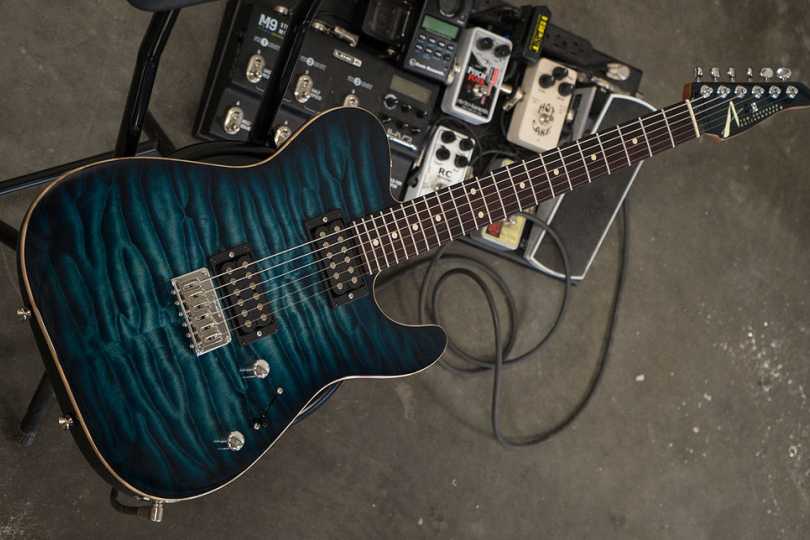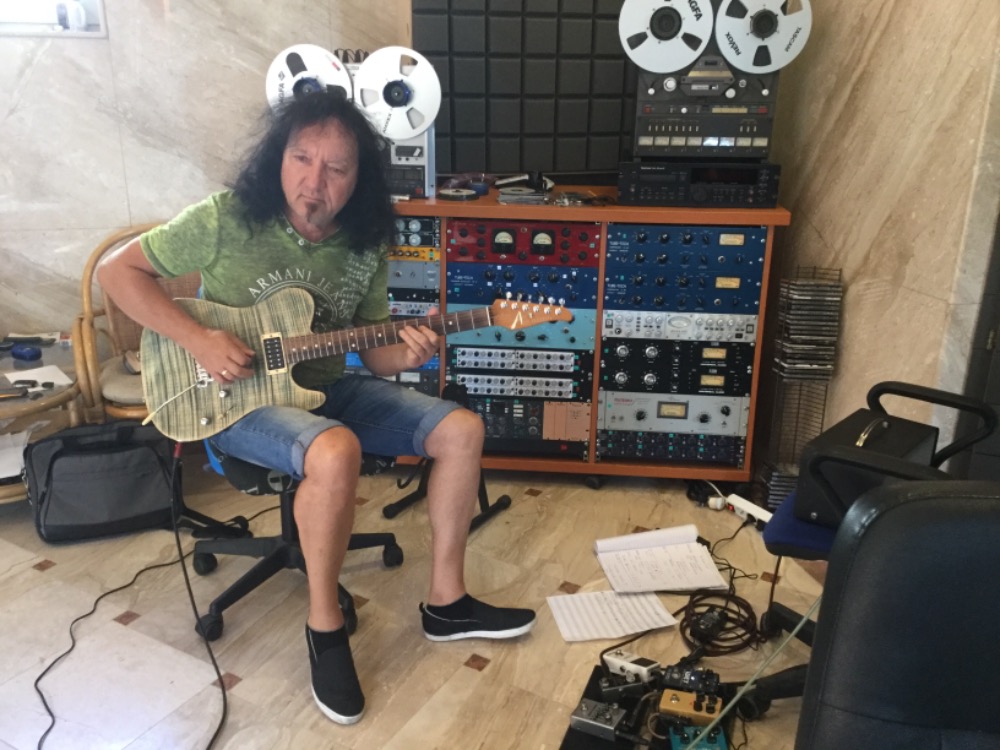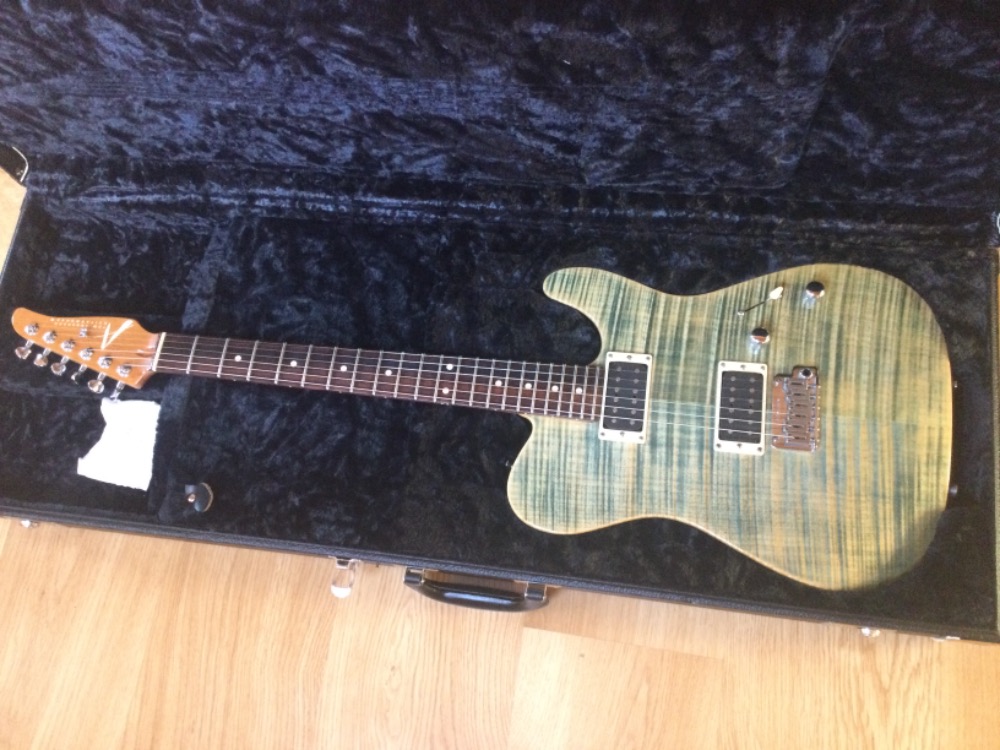
Legendary and Mythical Guitars #2: Tom Anderson Guitarworks
As the name suggests, this series will explore guitars that few people own, but many people dream about. We are going to look at brands that are rather rare or whose price falls into the "Unavailable" category. In many cases, it will be a combination of both. You may have heard the names, seen some top musicians playing them, but never researched their makers or history. Our series will primarily aim to explain the core philosophies of each manufacturer and help you get a better sense of what's going on at the top end of the guitar industry. We'll alternate between acoustic brands and electric brands, but of course, sometimes we'll feature both types of guitars from the same manufacturer. In the second part of the series, we'll take a look at Tom Anderson Guitarworks.
First meeting
Any guitar geek who ever finds himself in Budapest should definitely head to Korvín Square, not far from the Danube, and check out a store called Stageshop. There you can meet the owner, Ernö, a fun companion and great guitar expert, and his technician Zoltan, who can also repair guitars. After all, he was a guitar technician for the band Omega. You can discuss guitars for hours with them and learn a lot of things. Stageshop has gained worldwide fame over the years and is frequented by technicians from famous bands on their European tours as well as the musicians themselves, so you may even see some familiar faces.
Once, when I was sitting here tormenting a ToneKing, Two-Rock or whatever guitar it was, Ernö appeared in front of me posing like an evangelist, with his arms outstretched and holding a Strat in each hand. One had Suhr written on it and the other read Tom Anderson. He said to me: "Mike, try both and tell me which one is better." I already knew something about John Suhr, but the other name didn't ring a bell. So when I got home, I quickly googled it so I wouldn't look like an idiot.
California again
I found the following information: Tom Anderson Guitarworks is a privately held company based in Newbury Park, California. (As if those people in California have nothing else to do but make expensive guitars, that is unless they're surfing). Newbury Park is a place located in the outer suburbs of Los Angeles. The business was founded in 1984 and produces about 750 guitars a year.
If we dig a little deeper, we learn more context. Tom Anderson originally worked for Dave Schecter. Then he decided to try his luck, started his own company, and at first supplied guitar makers with parts like bodies, necks, pickups and the like. In 1985, he opened a small shop with a workshop and started building his own models. He chose the best wood and parts he could find and experimented with different manufacturing processes. The most significant technological advancement was the acquisition of a CNC machine and also the discovery of his own formula for UV lacquer – that is, lacquer that is "baked" on the wood by a UV lamp.
As the interest in fine guitars grew, Tom gradually expanded production, but very carefully so as not to lose the aura of exclusivity. Today he employs a team of people who split the production process between them. Nevertheless, the annual production volume does not exceed the upper hundreds. So it's no wonder you might have to wait a while to get your guitar.
Guitar Stories
There are two indicators of what Anderson is all about. The first is the name of the company – Tom Anderson Guitarworks. When you visit the T. A. or follow his social media, you'll find that the manufacturing process of each instrument is documented and then included in an archive called "Guitar Tales". Each of the stories also has a name and describes how the instrument turned from an idea into a reality. That in itself says something. Each guitar is conceived as an "opus", a work of art. Depending on the style of playing for which it is intended, it is approached individually and with the greatest care and attention.
Tom Anderson started his business by winding his pickups, which he sold to others. He stayed with that job even after he started making his own guitars. That's why one of the company's production departments is dedicated to developing and manufacturing the pickups that go into all of the guitars. Matching pickups to the type of wood and hardware of the guitar is one of the magic factors that brought Tom Anderson to the top of the pyramid of guitar makers. And if you don't quite trust him to get it right, you can pretty much configure your model yourself.
Buzz Feiten Tuning System
Buzz Feiten is an American guitarist with a long discography. He played at Woodstock with the Paul Butterfield Blues Band and then with many blues, fusion and pop greats such as Dave Weckl and Aretha Franklin. He liked to tinker with instruments and he used to get pretty pi**ed off by the same thing all of us guitar players do. Namely, if you tune D major in the second position and G major in the third position, C major is not so great, and E major is a mess – the Western tuning that can only be resolved by compromise.
Buzz tinkered with tuning for so long that he developed his own special system, based on manipulating the vibrating length of individual strings by having a specially adjusted nut and saddle. Also, the tuning method is a little different from the standard one. It benefits from the fact that the human ear is differently sensitive to the accuracy of different intervals. Buzz Feiten patented the system, and his own workshop, as well as other authorised workshops around the world, are allowed to modify guitars to work according to his design with his permission.
However, several guitar manufacturers have bought the patent and can use it on their instruments already in production. One of them is Tom Anderson. That's why his guitars are surprisingly well-tuned across all the common chords. It looks very metaphysical and supernatural, but in reality, it is simple down-to-earth physics used to trick the human ear when listening to tones in harmony.
So what can you choose from?
The factory offers eight standard models called The S, The T, Angel, Baritom, Bobcat, Cobra, Crowdster and Raven.
I probably don't need to describe to guitarists what the S and T are. Perhaps just a note that both the Strats and Telecasters range from "vintage" to "modern". Angel is the designation for Superstrats with six or seven strings, Bartitom (really spelt with an "m" at the end) is a Superstrat that is tuned from B to B. Bobcat is a quasi Les Paul or The Paul. Cobra are Strats and Telecasters made from exotic woods with a 24+3/4 scale, Crowdster is an acoustic/electric hybrid, roughly in the style of Taylor's T5. Oh, and the Raven is something like a Fender Jazzmaster.
These basic models may or may not be modified by the customer. So, for example, the neck profile, the material used, the finish, the pickups and the hardware can all be selected from several to many variations. In addition, there is a configurator on the website where you can model "your" guitar from scratch.
Where, how much... and especially when?
Clearly, the overwhelming majority of dealerships are in the US. There are a few in Asia, and the manufacturer has nine in Europe, for example, the above-mentioned Stageshop in Budapest and then Station Music in Munich. Usually, there are only a few pieces in the shop, because guitarists who want a Tom Anderson guitar often have their own idea of their dream instrument and therefore take advantage of the individual customisation options. However, guitars are ordered strictly through dealers. The company doesn't have its own e-shop where you could buy an instrument online.
The price of a single unit is usually between 4000 and 6000 euros – depending on the configuration. Of course, there are cheaper or more expensive exceptions.
If you choose a guitar directly from a dealer, you are set. You get to take it home. If you place a special order, the delivery time can vary greatly depending on which production slot you just hit and how many orders are ahead of you. If you are lucky, it will be four months to six months, but I've seen some who have waited over a year. However, if the outcome wasn't worth it, this business model would have collapsed long ago. I talked to Ed, the sales guy, a few days ago and he said they are swamped with orders and not keeping up at all. So I guess it's good.

The Cobra from Ostrava
In whose hands can you see this guitar with a strange A on the headstock? Brad Whitford, Bob Seger, David Crosby, Keith Richards, Neal Schon... I don't need to go on, do I?
I even know one owner personally. My friend, the guitar virtuoso Andonis Civopulos from Ostrava in the Czech Republic, also possesses the Cobra model. A beautiful instrument in the shape of a Telecaster, but with humbucking pickups and a tremolo. So it would be a pity not to ask Tony (as I call him) to share his impressions with our readers. He says that he enjoys both the shorter scale and the neck profile of the guitar. He finds it comfortable to play. The guitar has a five-position switch that changes pickups and also splits the coils, so it offers a decent range of sound possibilities. Again, Buzz Faiten tuning is part of the design. The only thing he would change is a little detail about the tremolo. He prefers a recessed lever thread as opposed to a top-screwed one.

To conclude
Limited production volume, a high degree of adaptation to individual requirements, quality materials, precise workmanship, custom pickups and special tuning adjustments. Commitment to this company philosophy has brought the business from the suburbs of Los Angeles worldwide fame.
"Why, Mr. Anderson? Why do you persist?" Agent Smith asks Neo, the savior of mankind, in The Matrix. Maybe Mr. Anderson who makes guitars was also sometimes advised to expand production, not to be such a "stickler" for quality, to go down on price, etc. But he too, thank God, persisted and resisted the temptation. And so, in his Guitar Matrix, more and more guitar stories will be added to the archive, one more beautiful than the other.
If you have found an error or typo in the article, please let us know by e-mail info@insounder.org.

